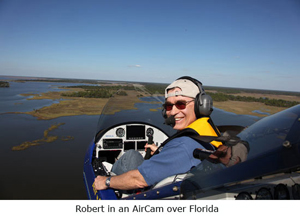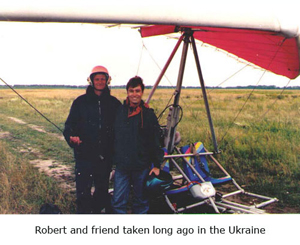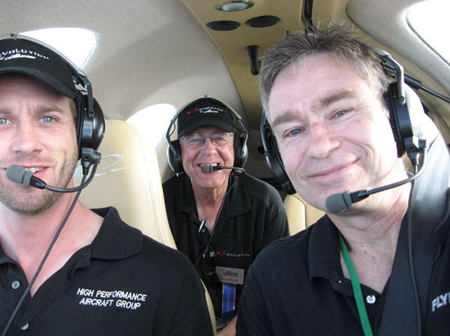Aircraft Spruce Canada
Brantford, ON Canada
Corona, CA | Peachtree City, GA
Chicago, IL | Wasilla, AK
Robert Goyer Editor Of Flying Magazine Talks Homebuilding By David Gustafson
| He’s the best man for the job. It’s doubtful that any man has taken the reins at FLYING with the kind of rich background Robert Goyer brings to the head quill. Robert was born into it. His family was already deeply involved in aviation by the time he arrived. While his dad, Norman Goyer, was working as a news director at a regional ABC affiliate in Western Massachusetts, he spent many weekends with the family at the friendly grass strip at Pilgrim Field in Hatfield, MA. Robert has vivid memories of watching his dad taxi out and takeoff in the Grumman FM-2 that Norm owned with five other guys. (None of them could have afforded the huge $2,800 purchase price on their own…you have to wonder how they could afford the gas?). Robert even has vivid memories of his first rides in an Aeronca Champ with his dad over the Massachusetts countryside. Along the way, Norman bought an SNJ, which Robert got some stick time in, and then his dad went and peeled a Cessna 190 off a ski slope, brought it home and with the help of his family, began rebuilding it. In the process he hung a 300 Jacobs on it and got the FAA to reclassify it as a Cessna 195. That was the family airplane for quite a while and it had been Robert’s hands-on introduction into a restoration project. Norman also introduced Robert to homebuilding, when he bought a set of plans for one of Bud Evans’ Volksplanes. He and Robert spent many hours poring over the plans, laid out on the living room floor, and commenting on Evans’ solutions for bulkheads, wing ribs and tail feathers. “My dad never bought part for the Volksplane,” said Robert. “With his work at the TV station, flying on the weekends and keeping the six of us in line, he didn’t have the time. But the plans gave us many hours of cheap, imaginative entertainment.” In 1973, Norman moved his family out to California, taking over operations at Apple Valley Airport in the Mojave Desert in California. Within a couple of years he owned three other desert FBOs. In his teens, Robert worked twisting wrenches in the shop or fueling aircraft and even in the diner with his mother, Tina, occasionally topping off the coffee cup of airport regular Roy Rogers…. Roy often used Norm’s office to discuss possible additions to his gun collection with brokers who flew in regularly. Apple Valley, under Norm’s tutelage became a very busy airport. In those days, Apple Valley Airport would see as many as 300 aircraft at the pumps between Friday night and Sunday night. A lot of pilots came in for the whole weekend, staying at the Apple Valley Inn, sight of the famous Red Room, which would pick them up and bring them back to the airport. It was a popular destination airport for a lot of Southern California pilots, as well as those from Arizona, Nevada and California. The magnetism of the Goyer Family had a kind of evangelical following. Robert claims a lot of the success it was due to his mom’s famous chili cheeseburgers. Over time, Robert and his three older brothers, worked at becoming private pilots. One of the brothers became a corporate pilot and an IA, another became an A&P, another brother and sister took flying lessons, and all of them in later years worked at the family’s various small FBOs in one capacity or another. Norman was an aviation adventurist in the best sense of the term. He is resourceful, articulate and a fine writer in his own right. “He is also,” Robert says, “a born pilot.” Years later Robert got his start in aviation journalism working for his father, at first doing stories for Scale R/C Modeler, which proved a challenging proving ground. Because precision scale modelers need to painstakingly document the aircraft they are replicating, Robert would often spend hours listening to master craftsmen describe the development of a perfectly scaled and detailed P-51, Sopwith Camel, Fairchild 24, or a Cabin Waco. It provided an immersion in history and in aircraft structural analysis. “It was a great learning ground for me,” said Robert, “because I had a chance to immerse myself in the details of these vintage airplanes, some of which no longer exist in full scale form. The master modelers were extremely knowledgeable and willing to share their expertise.” Robert also did some writing for Air Classics, which gave him an invaluable background in warbirds. He did in-depth interviews with pilots, like the man who had flown the ME-262 German jet and M-163 rocket plane against the Americans.
Around the same time Robert, who had been a pilot for a decade by then, saw his byline appear in full-scale aviation magazines, as well. After a few years, he got the break of succeeding his dad as editor of Sport Pilot, Hot Kits and Homebuilts, a small-circulation newsstand magazine dedicated to reporting on homebuilts, ultralights and anything else that was connected with recreational aviation. While at Sport Pilot the young writer found himself flying more than a hundred aircraft in the homebuilt and ultralight categories. This included well known designs like the CGS Hawk ultralights, various Quicksilvers, Flight Stars, Kitfoxes, RANS, Kolbs, Murphy’s, Avid Flyers, Glasairs, Glastars, Lancairs, and Questair Ventures, as well as lesser known models, like the Montana Coyote and KIS.“ At the same time, Robert began doing air-to-air photography, including homebuilts and ultralights. His work graced dozens of covers of Sport Pilot, Air Progress, Affordable Flying (a title he conceived and launched), and Air Classics, among others. He continues his work today as that rare bird, an editor in chief of a major aviation publication who is an accomplished air-to-air photographer. Half of last year’s Flying covers were images that Goyer captured. “Air to air photography is a passion. To be given the chance to try to translate the essence of an airplane in flight into a photograph that (hopefully) speaks to our readers is a true delight, and some of my favorite subjects have been homebuilts.” Robert added: “Starting my career writing about homebuilts was such a great opportunity for me, largely because it gave me the chance to talk to the people who had designed them. It gave me the opportunity to learn how they did they did what they did. These individuals, many of them untrained as aircraft designers, were so incredibly knowledgeable and resourceful, and it eventually occurred to me that what homebuilt kit makers like Randy Schlitter at RANS or Tom Peghiny at FlightStar were doing was the exactly same kind of endeavor that goes on at Boeing, only in miniature. “The ingenuity, perseverance and belief in one’s self that you could do something as complex as designing and producing an airplane and then a kit for that airplane…and then have hundreds of them out there…is mind-boggling. It’s a quintessential story of American achievement…the story of the rise of the homebuilt.
“You know Paul Poberezny is obviously the guy who brought a lot of that stuff together. But let’s face it, Paul wouldn’t have achieved the level of success he did without there being a ground swell of enthusiasm for this kind of activity that was going on all over the country and eventually overseas as well. A lot of it had to do with the fact that homebuilt enthusiasts were building airplanes that could be put together very inexpensively and they could then go flying in them. A lot of it was economics. Because they built it, they could have an airplane After a few years at the helm of Sport Pilot Magazine, Robert was hired to write for FLYING Magazine. That’s a rather extraordinary leap in venue. Sport Pilot was a niche market magazine. FLYING is a world view publication. “My world changed in every way imaginable. Instead of looking at airplanes as a form of recreation, I had to focus on transportation, on the airplane’s usefulness in a different way.” Almost immediately upon arriving at Flying, got his IFR rating and started to learn, he says, how much he did not know about flying. He had a lot to learn about flying from point A to B in IFR and controlled airspace in high performance airplanes. It was extremely challenging, rewarding, exciting and broadening. He quickly moved on to get his commercial rating, multi, seaplane, and then started flying jets. He is type rated in the Cessna CitationJet and plans to add others in the coming years. Turboprops and turbofans, which had seemed so distant, were suddenly a part of his daily existence. It’s a different world to be sure and Robert has found that the smell of kerosene can create a different kind of adventure, a new type of encounter with science and technology which has always captured his attention. But in the end, it’s still an experience of one man, one aircraft and one flight at a time. The relationship between the most sophisticated jets and simplest of ultralights reveals a direct connection. Robert’s roots clearly have given substantial depth and meaning to his encounters with Flight Level 350. He loves it all. Having flown more homebuilts than most of us have even looked at closely, Robert is hard pressed to look back on any of them in an unfavorable light. Some stand out for being excellent examples of the type of flying they represent. He can still appreciate the remarkable sensations and view from the front seat of an AirCam over the Everglades in Florida. Sitting up there in the nose of the world’s lightest twin, with a small windshield and an unobstructed view of the world below brings with it a sense of freedom that is as unique as the design. “The experience is just phenomenal. It’s a great design, a really fun airplane to fly. It flies nearly as well on one engine as two and the experience you get cruising at ten feet above the water looking at the gators below is fantastic. The Kitfox is another great airplane. I believe I’ve flown every model of the Kitfox that Dan Denney ever made. They were all a lot of fun. The Avid Flyer was another excellent design. These were very simple airplanes, very straight forward and great fun to fly. At the other end there’s the Lancair Evolution. It’s a fast airplane, pressurized and has a great range. Another one I really admire is the Flight Star. I have a lot of time in it and just enjoy cruising around the countryside in one. They really capture the spirit of the ultralight style. It gives you that incredible open, out- in-the-air flying experience. And that gives you a perspective on flying that’s rich and personally extremely rewarding.” Robert respects all of the homebuilt designers for their tenacity, creativity and accomplishment. He points to Dick Van Grunsven with a special feeling of admiration for the RV lineup. “The RVs are in a class by themselves. You get tremendous responsiveness and performance and they’re so easy to build. Robert believes that the homebuilding movement is still going strong. The number of people actually engaged in building an airplane today is certainly smaller than it was 10 or 20 years ago, he says, but that’s just a function of the culture and the current economy. The point is that the “thing” that has attracted people to homebuilding all along--the challenge, the sense of accomplishment, the pride of flying something you built with your own two hands--is still there today. There’s a lot of competition for peoples’ attention and time today, but once they see what the homebuilding process is all about, they’re attracted to it as strongly as they ever were. “It’s going to continue to be a vibrant segment of aviation and one that’s worthy of our attention at FLYING magazine. The industry would be sadly on the wrong track if we lost sight of that.” While Robert realizes that the costs of building an aircraft have gone up, they remain considerably lower than the prices of a new factory-built aircraft with similar performance. He believes that a four-seat RV would be available to a builder for a third of the cost of comparable performance in a new factory-built. The performance in a two-seat RV, for example, really has no comparison in speed and maneuverability, with existing certificated models. “The only thing is”, he is quick to add, “you do have to build the airplane. I think that one of the reasons that Van’s has been so successful is because they have been such a terrific value proposition for people. Flying is without question more expensive than it used to be, but there are still ways to do what you want to do for less, and homebuilding was and is one of those ways.” For those considering tackling a homebuilt project, Robert believes that it’s important to put as much time into researching the project as they do with the actual building. He feels that it makes good sense in some cases to put as much as a year or two getting ready before actually picking up the first tool. That time might be compressed somewhat for people who have been hanging around airplanes for many years and have a feel what’s already in an aircraft. For the beginner, it’s a good idea to take the time to develop the When asked about the contributions that homebuilding has made to General Aviation, without hesitating, Robert names the “the SR-22”. He adds: “When you look at the innovative technologies on the SR-22, many of them came directly from homebuilding. You’ve got composite construction, use of carbon fiber, the ballistic parachute recovery system, and the differential braking for steering on the ground. And you have two men, the Klapmeier brothers, who started the Cirrus aircraft company with a homebuilt design called the VK-30 and then moved into certification, hoping to make it simpler, easier and cheaper to build. They brought a lot of homebuilt technology with them, along with a sense of design, and adapted it. They weren’t alone. Cessna now has a derivative of the Lancair in the Columbia. The Liberty evolved from the Europa homebuilt and the Quicksilver GT became the certified Quicksilver GT-500, among others. There’s no substitute for freedom in design and innovation and that’s a freedom that homebuilding has enjoyed and utilized for decades. That’s why you see a lot of the top people at Boeing and Grumman wandering around the flightline at AirVenture: they talk with the designers and are eager to learn what’s new. It’s a source of new ideas and innovation and we all need that. And that’s why Flying will always keep a close eye on what happens in the world of homebuilt aircraft.”
|

 Aircraft Spruce Canada
Aircraft Spruce Canada


